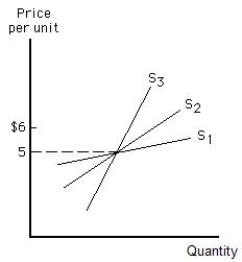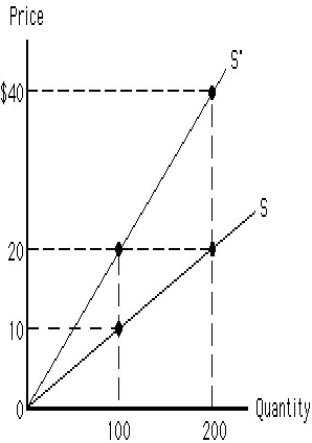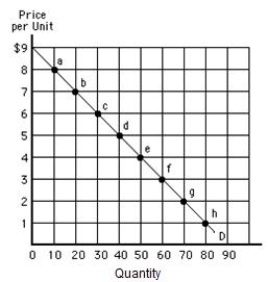A) price inelastic.
B) income inelastic.
C) income elastic.
D) goods with negative income elasticity.
E) goods with positive price elasticity.
Correct Answer

verified
Correct Answer
verified
Multiple Choice
The cross-price elasticity of demand is used to determine whether:
A) a product is an inferior or normal good.
B) a product is a necessity or a luxury.
C) two products are substitutes or complements.
D) price and total revenue are directly or inversely related.
E) the product's demand curve is linear.
Correct Answer

verified
Correct Answer
verified
Multiple Choice
Given the proportion of a consumer's income spent on various goods, the demand for _____ is likely to be the most price inelastic.
A) furniture
B) automobiles
C) hotel rooms
D) airline travel
E) candy bars
Correct Answer

verified
Correct Answer
verified
Multiple Choice
Goods with an income elasticity of demand greater than 1 are called:
A) necessities.
B) inferior goods.
C) substitutes.
D) luxuries.
E) complements.
Correct Answer

verified
Correct Answer
verified
True/False
Price elasticity is 1 at the midpoint of a linear downward-sloping demand curve.
Correct Answer

verified
Correct Answer
verified
Multiple Choice
If a 5 percent increase in price leads to an 8 percent decrease in quantity demanded, demand is:
A) perfectly elastic.
B) elastic.
C) unit elastic.
D) inelastic.
E) perfectly inelastic.
Correct Answer

verified
Correct Answer
verified
Multiple Choice
For which of the following is demand most likely to be perfectly inelastic?
A) BMW automobiles.
B) Pepsi Cola.
C) Hot dogs.
D) Insulin.
E) Tylenol.
Correct Answer

verified
Correct Answer
verified
Multiple Choice
The price elasticity of demand is typically negative because:
A) as price decreases, quantity demanded decreases.
B) as price decreases, quantity demanded increases.
C) as price decreases, demand decreases.
D) as price decreases, demand increases.
E) consumers rarely respond to a change in price.
Correct Answer

verified
Correct Answer
verified
Multiple Choice
Which of the following does not determine a good's price elasticity of demand?
A) The time interval considered
B) The number of substitutes available for the good
C) Expenditure on the good as a percentage of the total consumer budget
D) The slope of the demand curve
E) The more of a luxury a particular good is
Correct Answer

verified
Correct Answer
verified
Multiple Choice
The price elasticity of demand is calculated as:
A) the percentage change in quantity demanded divided by the percentage change in price.
B) the percentage change in price divided by the percentage change in quantity demanded.
C) the absolute change in quantity demanded divided by the absolute change in price.
D) the absolute change in price divided by the absolute change in quantity demanded.
E) price multiplied by quantity demanded at that price.
Correct Answer

verified
Correct Answer
verified
Multiple Choice
If a price reduction leads to an increase in total revenue, demand is:
A) perfectly inelastic.
B) inelastic.
C) unit elastic.
D) elastic.
E) perfectly elastic.
Correct Answer

verified
Correct Answer
verified
Multiple Choice
If an increase in price from $1.20 to $2 per unit leads to an increase in quantity supplied from 20 to 100 units, then:
A) supply is perfectly elastic.
B) supply is perfectly inelastic.
C) supply is unit elastic.
D) supply is elastic.
E) supply is inelastic.
Correct Answer

verified
Correct Answer
verified
Multiple Choice
Which of the following determines a firm's revenue when it changes the price of its product?
A) The firm's cost function
B) The elasticity of the firm's total product curve
C) The plant size used by the firm in the long run
D) The price elasticity of demand for the firm's product
E) The price elasticity of supply
Correct Answer

verified
Correct Answer
verified
Multiple Choice
Figure 5.9 shows three upward-sloping linear supply curves. Which of the following supply curves is the most elastic and which is the least elastic between the prices of $5 and $6? Figure 5.9

A) S1 is the most elastic; S2 is the least elastic.
B) S1 is the most elastic; S3 is the least elastic.
C) S3 is the most elastic; S1 is the least elastic.
D) S3 is the most elastic; S2 is the least elastic.
E) S2 is the most elastic; S3 is the least elastic.
Correct Answer

verified
Correct Answer
verified
Multiple Choice
If the cross-price elasticity of demand is −3, then:
A) the goods are substitutes.
B) the goods are unrelated.
C) one of the two goods is an inferior good
D) one of the two goods is a luxury.
E) the goods are complements.
Correct Answer

verified
Correct Answer
verified
Multiple Choice
Figure 5.10 shows two upward-sloping linear supply curves that pass through the origin. Which supply curve is more elastic in the figure below? Figure 5.10

A) Both S and S' have the same elasticity.
B) S is more elastic at lower prices, and S' is more elastic at higher prices.
C) S is more elastic at higher prices, and S' is more elastic at lower prices.
D) S is more elastic than S'.
E) S' is more elastic than S.
Correct Answer

verified
Correct Answer
verified
Multiple Choice
Table 5.5 shows the quantity supplied and the quantity demanded for restaurant meals at different prices. Use the information in the table below to calculate the price elasticity of supply for restaurant meals. Table 5.5

A) 7
B) 2
C) 1/2
D) 3/5
E) 5/3
Correct Answer

verified
Correct Answer
verified
Multiple Choice
Figure 5.4 shows a downward-sloping linear demand curve. Which of the following is true between points g and h in the figure below?
Figure 5.4

A) Total revenue remains constant at $180
B) Total revenue falls by $12.
C) Total revenue falls by $60.
D) Total revenue falls by $180.
E) Total revenue increases by $300.
Correct Answer

verified
Correct Answer
verified
Multiple Choice
Table 5.3 shows the quantity supplied and the quantity demanded for restaurant meals at different prices. Use the information in the table below to calculate the value of the price elasticity of demand for restaurant meals. Table 5.3

A) −1/2
B) −5/3
C) −3/5
D) −3/7
E) −7/3
Correct Answer

verified
Correct Answer
verified
Multiple Choice
Which of the following describes a situation in which demand must be inelastic?
A) Total revenue decreases by 10 percent when the price of spats rises by 10 percent.
B) Total revenue decreases by less than 10 percent when the price of spats rises by 10 percent.
C) Total revenue increases by more than 10 percent when the price of spats rises by 10 percent.
D) Total revenue decreases by $10 when the price of spats rises by $10.
E) Total revenue decreases by more than $10 when the price of spats rises by $10.
Correct Answer

verified
Correct Answer
verified
Showing 41 - 60 of 149
Related Exams